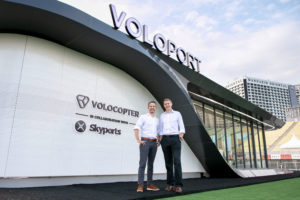 This morning at Amsterdam Drone Week, a panel of top players in the urban air mobility (UAM) industry talked about multi modal hubs – how passenger eVTOLS can be integrated into existing modes of transportation.
This morning at Amsterdam Drone Week, a panel of top players in the urban air mobility (UAM) industry talked about multi modal hubs – how passenger eVTOLS can be integrated into existing modes of transportation.
UIC2 is the intiative of cities around the world to plan for UAM development – creating mobility as a service in a sustainable way. These cities are committed to integrating UAM into their existing transportation systems, combining all modes of public transit like buses, taxis, trains, and bike rentals with air mobility solutions. This integration will create multi modal mobility hubs, giving users the opportunity to access the most efficient mode of transportation for their needs – and realizing the vision of easy, sustainable and environmentally friendly transport in cities.
How Cities Around the World are Preparing for UAM and Multi Modal Mobility Hubs
Henk Hesselink, from Netherlands Aerospace Center NLR focused on UAM opens the discussion with an image of their office building with a vertiport on the roof of the building. Their vision for UAM is focused on city development: “We can make it possible if the community makes it possible,” says Hesselink. “[UAM] needs to be not only for rich people, but available for everyone… and it isn’t only about transportation, but about delivery.” Hesselink says that beyond taxi drones, which are a large part of the UAM concept, in the Netherlands they are considering how to leverage UAM vehicles for other purposes such as package delivery and aerial imagery.
Climate Neutrality
Ivo Cré of Belgian-based POLIS says that in order to make it happen, “We really need to urbanize urban air mobility.”
“Our cities are very focused on achieving climate neutrality.” In introducing a new mobility culture, he says, it’s important to focus on the ways that UAM can help meet that goal. Secondly, Cré says that his research indicates a large gap in the trust levels between the UAM industry and the public. Other innovative modes of transport, such as ride-hailing, caused major disruption in existing transit systems like ground taxis, he points out. For UAM to be successful, communities must plan carefully to “de-risk” operations – ensure that there is as little disruption to existing systems, jobs, and citizens as possible.
Democratizing Air Mobility
IBG in Sweden is focused on bringing UAM out of the city to support the suburbs and rural areas, also. In addition to a focus on climate neutrality, IBG says that they want to ensure that every citizen can utilize eVTOL transportation for the price of a (ground) taxi ride.
The group is developing multi modal hubs – vertiports – that look like busstops. The concept is that citizens can check in via an app: and the vertiport will be used and scheduled according to the needs of the local community. For communities in the northern part of the country, eVTOL transportation could significantly shrink commutes and bring access to jobs and economic opportunities.
Providing Services to Remote Areas
In Japan, they are also focused on helping people in remote areas. Momoko Wada, from the Mie Prefecture, says that Mie has a population of about 1.8 million, between Tokyo and Osaka: and many regions have experience depopulation. There is no Shinkasen (speed train) or airport in the Mie Prefecture: and it takes about 3 hours to travel from the nearest airport to the southern region by car. UAM offers three major benefits: support for citizens’ daily lives, new transportation options for tourists, and to help with disaster relief.
The Japanese government plans to start UAM programs to travel from the more remote areas into cities, rather than starting from the city. “We don’t have the same traffic problems that some of the European cities have,” she says. “We’re going to demonstrate UAM in remote areas first.”
Shifting Paradigms
Sante Consiglio of Groupe ADP Paris, developers of the Paris airport, says that UAM is one part of moving from car-centric tranport to multi-modal transport, in order to meet city goals of zero-emissions and congestion management. UAM is only one part of a larger master plan that the city is developing to redefine and enrich ground mobility as well as introduce new modes of transport. “When we think about shifting paradigms, we need to think about the business aspect as well,” he says. “About 10 % of our business is based on car transportation, through parking fees and more.”
The new master plan for transportation in and out of airports, considers shifing to a classical hub and spoke model of transportation: evaluating places where innovative forms of transportation may be offered successfully.
Read more about UAM:
Miriam McNabb is the Editor-in-Chief of DRONELIFE and CEO of JobForDrones, a professional drone services marketplace, and a fascinated observer of the emerging drone industry and the regulatory environment for drones. Miriam has penned over 3,000 articles focused on the commercial drone space and is an international speaker and recognized figure in the industry. Miriam has a degree from the University of Chicago and over 20 years of experience in high tech sales and marketing for new technologies.
For drone industry consulting or writing, Email Miriam.
TWITTER:@spaldingbarker
Subscribe to DroneLife here.
https://dronelife.com/2022/03/30/multi-modal-mobility-hubs-and-uam-from-the-floor-of-amsterdam-drone-week/
 Unmanned Aerial Vehicle The latest drone news
Unmanned Aerial Vehicle The latest drone news



